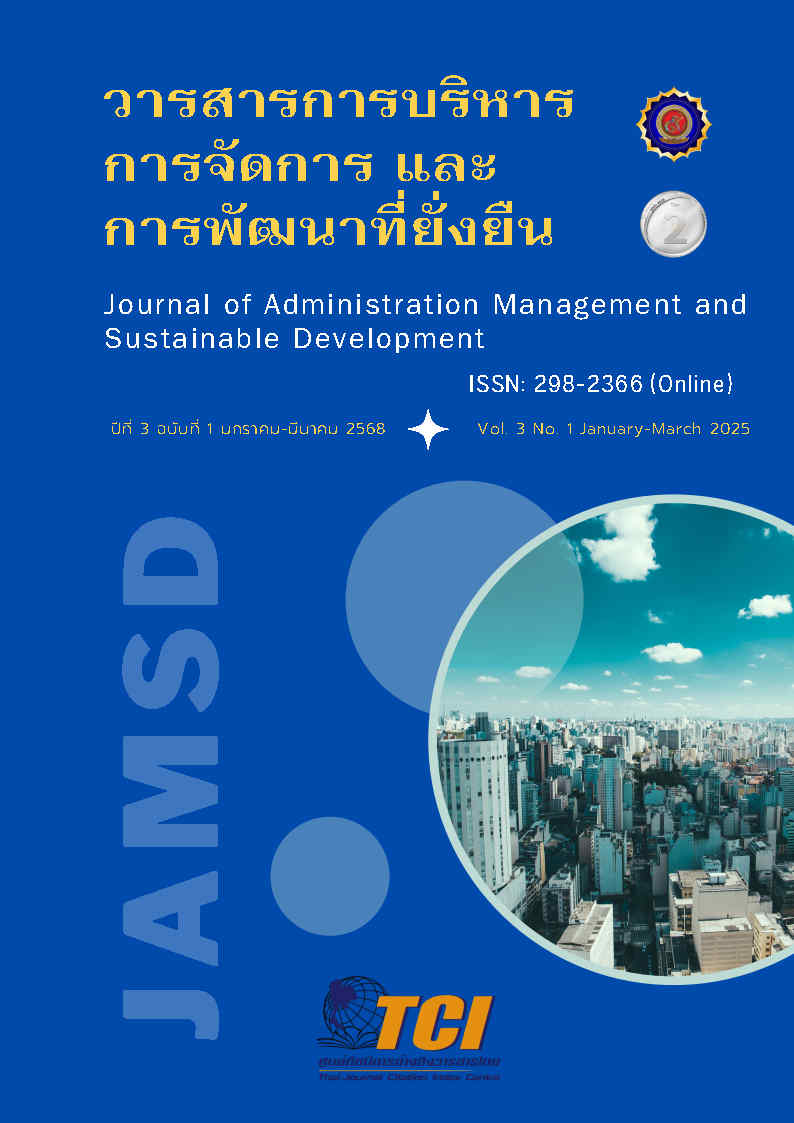The development of English pronunciation ability and academic achievement through Communicative Language Teaching (CLT) accompanied with phonics instruction among Grade 5 students
Keywords:
communicative language teaching (CLT), phonics instruction, English pronunciation ability, English learning achievementAbstract
The objectives of this study were to 1. develop instructional management using Communicative Language Teaching (CLT) accompanied with phonics instruction for Grade 5 students to achieve the efficiency criterion of 75/75. 2. Compare the English pronunciation ability of Grade 5 students taught using CLT combined with phonics instruction with the benchmark of the 75 percent criterion and 3. compare the learning achievement in English after instruction using CLT accompanied with phonics instruction with the criterion of 75%. The sample consisted of 42 Grade 5 students from Anuban Phonthong School, located in Waeng Sub-district, Phonthong District, Roi Et Province, during the second semester of the 2024 academic year. The research instruments included lesson plans, an English pronunciation ability test, and an English learning achievement test. This research analyzed the data using percentages, mean, standard deviation, and one-sample t-tests. The results were as follows: 1. The learning management approach that integrates Communicative Language Teaching (CLT) with phonics instruction for Grade 5 students achieved an efficiency score of 81.21/80.54, which is higher than the predetermined criterion. 2. Students taught with the learning management approach that combines Communicative Language Teaching (CLT) and phonics instruction demonstrated English reading aloud proficiency above the specified 75 percent criterion at
a statistically significant level of .05. 3. Students who were taught using a combination of Communicative Language Teaching (CLT) and phonics instruction did better in school after learning than the required 75% threshold, which was statistically significant at the 0.05.
References
กระทรวงศึกษาธิการ. (2551). หลักสูตรแกนกลางการศึกษาขั้นพื้นฐาน พุทธศักราช 2551 (พิมพ์ครั้งที่ 3). กรุงเทพฯ: โรงพิมพ์ชุมนุม สหกรณ์การเกษตรแห่งประเทศไทย จำกัด.
จีรนันท์ เมฆวงษ์. (2547). การพัฒนาความสามารถในการออกเสียงภาษาอังกฤษและความคงทนในการเรียนรู้คำศัพท์ด้วยวิธีการสอนแบบโฟนิกส์. วิทยานิพนธ์ศึกษาศาสตร์มหาบัณฑิต มหาวิทยาลัยเชียงใหม่.
ณภัทร นรชาญ, สิราวรรณ จรัสรวีวัฒน์ และเด่นชัย ปราบจันดี. (2566). ผลการสอนภาษาเพื่อการสื่อสาร (CLT) และการออกเสียงภาษาอังกฤษแบบ LINGUA FRANCA CORE ที่มีต่อผลสัมฤทธิ์ทางการเรียนวิชาภาษาอังกฤษ และทักษะการออกเสียงภาษาอังกฤษของนักเรียนชั้น มัธยมศึกษาปีที่ 3. e-Journal of Education Studies, Burapha University, 5(2), 16–30. https://so01.tci-thaijo.org/index.php/ejes/article/view/262891.
นฤมล สุปินโน. (2558). ผลการใช้วิธีสอนแบบโฟนิกส์ เพื่อพัฒนาทักษะการอ่านออกเสียงภาษาอังกฤษ และเจตคติ ต่อการอ่านแบบโฟนิกส์ของนักเรียนชั้นประถมศึกษาปีที่ 2 โรงเรียนบ้านนาป่าแปก จังหวัดแม่ฮ่องสอน. วิทยานิพนธ์ศึกษาศาสตรมหาบัณฑิต สาขาวิชาศึกษาศาสตร์ มหาวิทยาลัยสุโขทัยธรรมาธิราช.
พรชัย ผาดไธสง. (2560). การพัฒนาหลักสูตร. นครราชสีมา: โฟโต้บุ๊คดอทเน็ต.
พรสวรรค์ สีป้อ. (2550). สุดยอดวิธีสอนภาษาอังกฤษ นำไปสู่การจัดการเรียนรู้ของครูยุคใหม่. กรุงเทพฯ: อักษรเจริญทัศน์.
พิมพ์พร บังวัด (2563). การพัฒนากิจกรรมการเรียนรู้ภาษาเพื่อการสื่อสารประกอบสื่อประสม เพื่อส่งเสริมความสามารถในการฟังและการพูดภาษาอังกฤษของนักเรียนชั้นมัธยมศึกษาปีที่ 2. วิทยานิพนธ์การศึกษามหาบัณฑิต สาขาวิชาหลักสูตรและการสอน มหาวิทยาลัยมหาสารคาม.
พิมภรณ์ พวงชื่น และวิวัฒน์ มีสุวรรณ์. (2563). การพัฒนาทักษะการอ่านออกเสียงและสะกดคำภาษาอังกฤษด้วยชุดกิจกรรมการเรียนการสอนแบบโฟนิค สำหรับนักเรียนระดับชั้นประถมศึกษาปีที่ 1. วารสารวิชาการวิทยาลัยสันตพล, 6(1), 19–29.
ไพพรรณ อินทนิล. (2546). การส่งเสริมการอ่าน. ชลบุรี: ชลบุรีการพิมพ์.
โรงเรียนอนุบาลโพนทอง. (2566). สรุปรายงานผลสัมฤทธิ์ทางการเรียนภาเรียนที่ 2 ปีการศึกษา 2566. ร้อยเอ็ด: สำนักงานเขตพื้นที่การศึกษาประถมศึกษาร้อยเอ็ดเขต 3
ละเอียด จุฑานันท์. (2541). แนวการจัดการเรียนการสอนวิชาภาษาอังกฤษ. กรุงเทพฯ: สถาบันพัฒนาคุณภาพวิชาการ.
ลำยง เครือคำ. (2555). การพัฒนาแบบฝึกทักษะการเขียนเรียงความโดยใช้แผนที่ความคิด สำหรับนักเรียนชั้นมัธยมศึกษาปีที่ 2. วิทยานิพนธ์ครุศาสตรมหาบัณฑิต มหาวิทยาลัยราชภัฏบุรีรัมย์.
วิไล ตันเสียงสม. (2548). การพัฒนาความสามารถด้านการฟังและการอ่านภาษาอังกฤษ ของนักเรียนชั้นมัธยมศึกษาปีที่ 1 ด้วยวิธีการสอนภาษาเพื่อการสื่อสาร. วิทยานิพนธ์ศึกษาศาสตรมหาบัณฑิต สาขาวิชาหลักสูตรและการนิเทศมหาวิทยาลัยศิลปากร.
วิบูลศรี กิ่งแก้ว. (2552). การพัฒนาชุดการเรียนด้วยตนเอง วิชาาภาษาไทย เรื่องลลิติตะเลงพ่าย สำหรับนักเรียนชั้นมัธยมศึกษาปีที่ 5 โรงเรียนเซนต์โยเซฟทิพวัล. สารนิพนธ์การศึกษามหาบัณฑิต สาขาวิชาการมัธยมศึกษา มหาวิทยาลัยศรีนครินทรวิโรฒ.
สันทนา สุธาดารัตน์. (2557). ภาษาศาสตร์สำหรับครู (พิมพ์ครั้งที่ 2). กรุงเทพฯ: สำนักพิมพ์มหาวิทยาลัยรามคำแหง.
แสงระวี ดอนแก้วบัว. (2558). ภาษาศาสตร์สำหรับครูสอนภาษาอังกฤษ. กรุงเทพฯ: สำนักพิมพ์แห่งจุฬาลงกรณ์มหาวิทยาลัย.
Anderson, R. C. (1985). Role of Reader’s Schema in Comprehension, Learning, and Memory. In H. Singer & R. B. Ruddell (Eds.), Theoretical Models and Processes of Reading (3rd ed., pp. 372–384). Newark, DE: International Reading Association.
Harris, D. P. (1996). Testing English as a Second Language. New York: McGraw-Hill.
Hempenstall, K. (2002). Phonological processing and phonics: Towards an understanding of their relationship to each other and to reading development. Australian Journal of Learning Disabilities, 7(1), 4–28. https://doi.org/10.1080/19404150209546689
Weaver, C. (1994). Reading Process and Practice from Socio-Psycholinguistics to Whole Language (2nd ed.). Portsmouth, NH: Heinemann.






